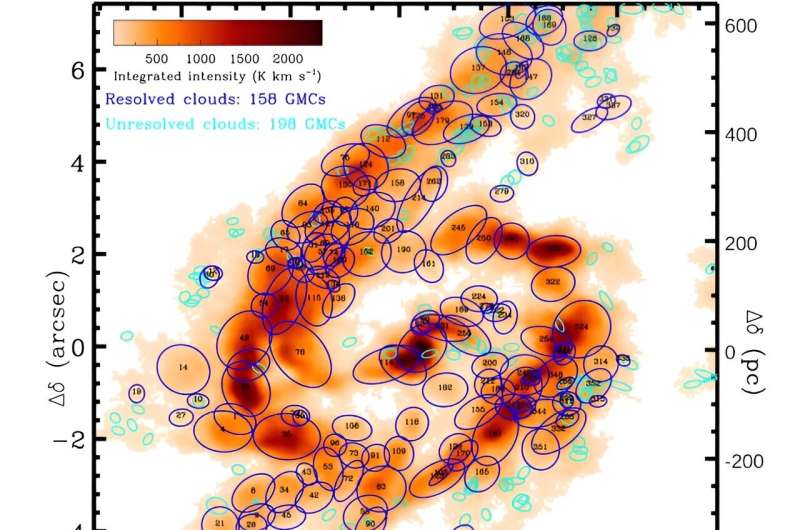June 5, 2024 report
This article has been reviewed according to Science X's editorial process and policies. Editors have highlighted the following attributes while ensuring the content's credibility:
fact-checked
preprint
trusted source
proofread
Astronomers investigate giant molecular clouds in the galaxy NGC 613

Using the Atacama Large Millimeter/sub-millimeter Array (ALMA), an international team of astronomers has performed high-resolution observations of a nearby galaxy known as NGC 613. Results of the observational campaign, published May 30 on the preprint server arXiv, shed more light on the numerous giant molecular clouds in the center of this galaxy.
Molecular clouds are huge complexes of interstellar gas and dust left over from the formation of galaxies, composed mostly of molecular hydrogen. Molecular clouds with masses greater than 100,000 solar masses are called giant molecular clouds (GMCs). In general, GMCs are 15–600 light years in diameter and are the coldest and densest parts of the interstellar medium.
GMCs are gas reservoirs where most star formation takes place. Therefore, studying their lifecycle and characteristics is crucial to advance our knowledge about the formation and evolution of galaxies.
At a distance of some 57 million light years, NGC 613 is a nearby barred spiral galaxy with a total stellar mass of about 45 billion solar masses. The galaxy has a bright core and a star-forming nuclear ring.
Previous observations of NGC 613 have found that it hosts GMCs in and around its nuclear ring. Recently, a group of astronomers led by Woorak Choi of the Yonsei University in South Korea, decided to take a closer look at these GMCs, exploring their properties with ALMA.
"NGC 613 was observed in the 12CO(1-0) line (rest frequency 115.271 GHz) using the Atacama Large Millimeter/sub-millimeter Array," the researchers wrote.
ALMA observations allowed Choi's team to identify 356 GMCs in NGC 613, out of which 158 are spatially and spectrally resolved. It turned out that the GMCs in this galaxy have sizes between 49 and 244 light years, while their velocity dispersions range from 2 to 36 km/s. The molecular gas masses of the GMCs in the sample were found to be 0.3–50 million solar masses, and their molecular gas mass surface densities were estimated to be within the range of 100–6,000 solar masses/pc2.
By comparing the GMCs of NGC 613 to that of the Milky Way disk and Local Group galaxy GMCs, the astronomers found that those in the investigated galaxy have comparable sizes. However, the GMCs reported in the paper have generally larger velocity dispersions, molecular gas masses and molecular gas mass surface densities.
Analyzing the distribution of the identified GMCs in NGC 613, the scientists found that sizes are similar across the different regions of the galaxy. However, the GMCs in the dust lanes of NGC 613 appear to have molecular gas masses, velocity dispersions and gas mass surface densities smaller than those of the GMCs in the other regions. The team also found that the GMCs in the arcs tend to have gas masses and gas mass surface densities larger than those of the GMCs in the other regions of NGC 613.
According to the paper, the investigated giant molecular clouds are marginally gravitationally bound, and the GMCs in the arcs tend to have smaller virial parameters than the GMCs in the other regions of the galaxy. The obtained results also suggest that the characteristic cloud lifetime of GMCs in NGC 613 is around 3-8 million years.
More information: Woorak Choi et al, WISDOM Project—XXI. Giant molecular clouds in the central region of the barred spiral galaxy NGC 613: a steep size—linewidth relation, arXiv (2024). DOI: 10.48550/arxiv.2405.19709
Journal information: arXiv
© 2024 Science X Network




















